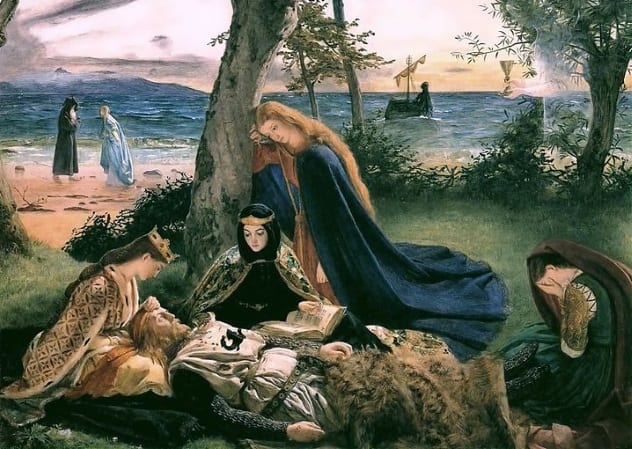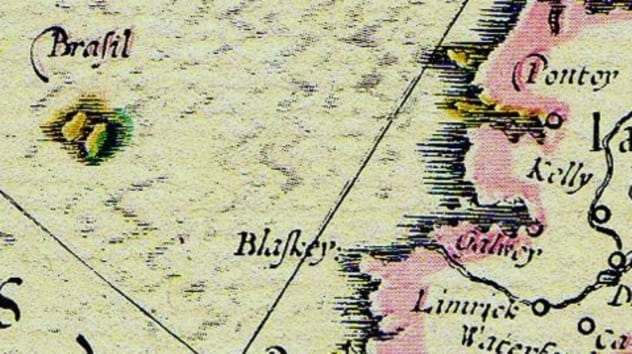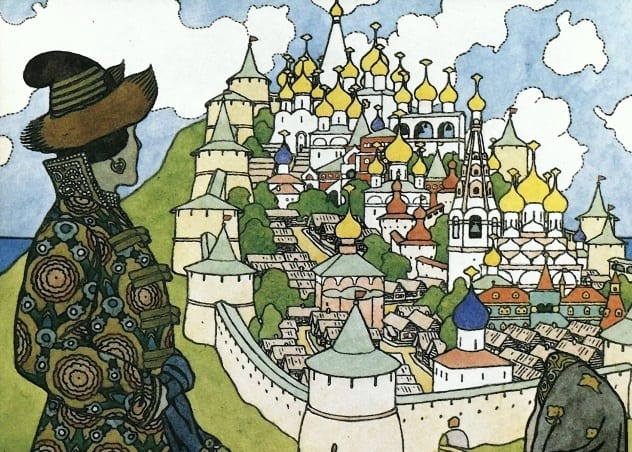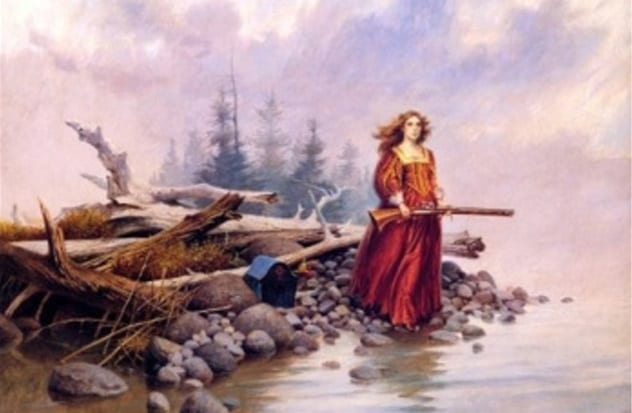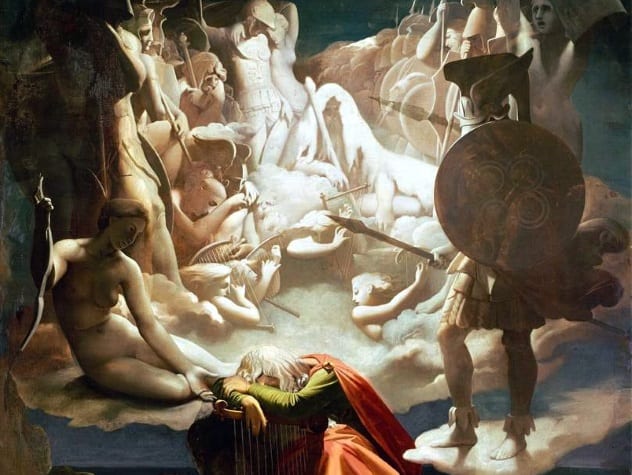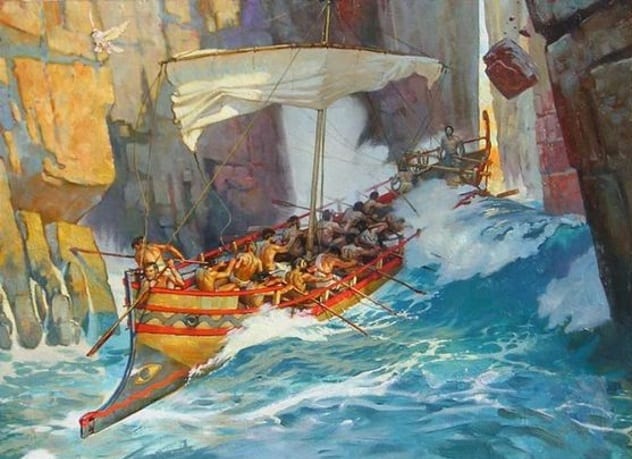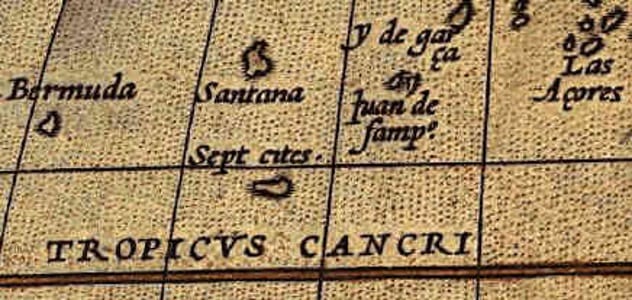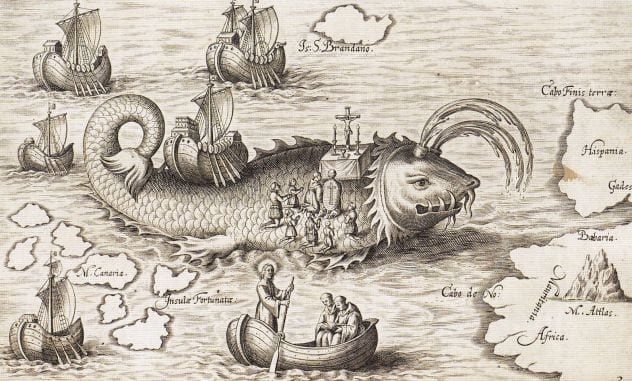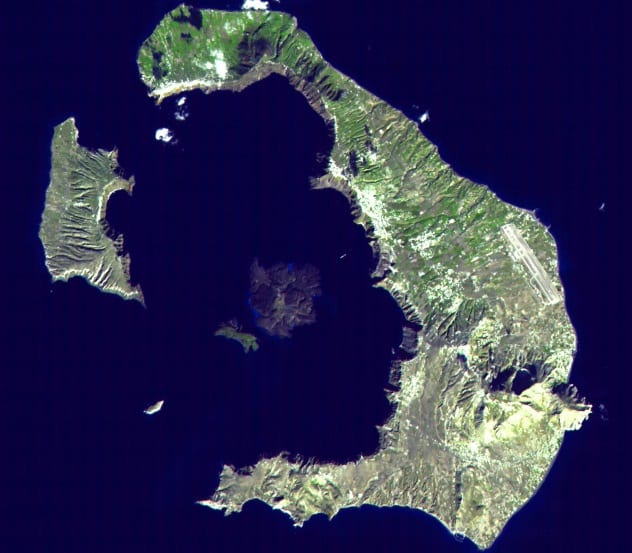How many sailors have spotted an island on the horizon and wondered if it meant salvation or a supernatural threat? Here are ten mysterious islands from folklore that brave readers may want to set sail for.
10 Avalon
King Arthur, the legendary king of the Britons, was much like the modern crop of British royals—he had marital troubles. When he discovered his queen was having an affair with Sir Lancelot, he pursued the naughty knight to France. While Arthur was out of the kingdom, it was taken over by the nefarious Mordred. On Arthur’s return, a battle was fought to regain Britain. In the fight, Mordred was slain, but Arthur was mortally wounded. He was placed on a barge, which took him from our world and deposited him on the magical isle of Avalon.[1] Avalon, the Isle of Apples, was the enchanted island where the sword Excalibur was forged. It was also home to the witch Morgen. It was apparently hoped that her powers would be able to heal the dying king. Legends differ on what happened to Arthur. Perhaps he was healed, or perhaps he was placed in a sorcerous sleep. All agree that Arthur is not gone forever. When Britain needs his help, he will return from Avalon. Many have attempted to find Avalon. Some believe that it is an island in the Atlantic, just off the coast of Britain. Others have seen the island of Avalon as a poetic description of Glastonbury Tor, a hill that is often surrounded by mists and looks like an island floating above the land.
9 Hy-Brasil
Before Brazil was known to Europeans, there was Hy-Brasil, an island to the west of Ireland. Hy-Brasil was shown on nautical maps for centuries before finally being removed from charts in the 1860s.[2] Irish legend had long talked about lands to the west which intrepid voyagers had found, but Hy-Brasil was their most enduring myth. When John Cabot, the first European to land on the North American mainland since the Vikings, returned from his expedition, it was reported that he had been led to lands “discovered in the past by the men from Bristol who found Brasil.” As exploration became more intense and there were fewer places for Hy-Brasil to hide on the map, legends rose to explain its absence. It was supposedly always surrounded by thick fogs except for one day every seven years, for instance. Maps began to show the island as an ever-smaller feature until it was labelled merely as Brasil Rock, a lonely mountain in the sea. One expedition that claimed to have landed on Hy-Brasil reported that it was inhabited by huge black rabbits and a single magician. From his lonely stone castle, the magician distributed gold and silver to the visitors.
8 Aeaea
In ancient Greek mythology, Aeaea was an island that was home to the sorceress and goddess Circe. The island was also mentioned in Homer’s epic poem, The Odyssey, when Odysseus says that he spent a year there, lured by Circe, on his voyage back to his home in Ithaca. Circe gave Odysseus directions about how to use the North Wind to cross the ocean on his way to the underworld. Classical Roman writers later referred to the island as Mount Circeo on the western coast of Italy and southwest of Rome. Although this might have looked like an island because of the sea and marshlands, it is actually a tiny peninsula, although it could have been an island in Homer’s day. Archaeologists found one cave on the cape and named it Grotta della Maga Circe, the Cave of the Circle. It may have been Circe’s winter home. A second cave on the close-by island of Ponza is thought to have been her mythical winter home. Many of the sites Homer talks about in his famous writings can be traced to an actual geographical place. On the other hand, Aeaea seems to be a mysterious place with a witch’s retreat that reminds the reader of fairy tale destinations. In the stories, lions and wolves wander peacefully around like gentle household pets, a scene not likely to happen in reality[3]. The mythical island was also a part of other literary works, including Richard Aldington’s 1933 novel All Men Are Enemies and John Banville’s 1993 novel Ghosts.
7 Buyan
In Slavic folklore, the island of Buyan is a sort of paradise. It is home to the Sun and the winds and is the island from which all weather comes. Seeds from every plant in the world can be found there.[4] Unfortunately for those searching for this heaven on Earth, the island of Buyan has a habit of disappearing and reappearing at random. To make the island even more tempting to explorers, it contains at its center a magical white stone called Alatyr. It is said to mark the center of the universe, and from it flow rivers with the ability to heal all injuries and sicknesses. Anyone who finds Alatyr will be granted happiness forever. Before you pack your boat to go in search of Buyan, you should know that it is guarded both by a bird called Gagana with metal claws and a beak of iron and by a magical snake.
6 Isle Of Demons
The Isle of Demons should perhaps consider changing its name if it wants to encourage tourism. Though given what is said to lurk there, perhaps they don’t. It also makes a terrible honeymoon destination, as a young bride named Marguerite was to find out. Married to a French noble, it seems the young Marguerite was traveling to meet him in the New World. She was also attracted to a handsome ship designer who was on the mission, it seems. The commander was upset with the scandalous behavior of the young bride and did what any psychopath would do: He abandoned her on an island known as the Isle of Demons.[5] No one lived on the island because it was said that the demons that inhabited it would tear any visitors apart. Marguerite was left to fend off the demons with her lover and nurse with only three months’ worth of provisions. Marguerite was the sole survivor of the three left on the island when rescued by another ship two years later. Little is known of her later life, or the location of the Island of Demons.
5 Tir Na Nog
The west coast of Ireland boasts an unusual number of mythological islands. One that many people would love to visit is Tir na Nog—the isle of eternal youth. There is no sickness, no pain, and no hunger on the island. Mead and beer flow, and everyone is happy. Hangovers also apparently do not occur. One story of Tir na Nog involves the Irish hero Oisin. Niamh, a beautiful young maiden from Tir na Nog, was riding by when Oisin saw her. Immediately, he fell in love with her. Riding on a magical horse, he was able to visit the island with Niamh. He spent a full year on Tir na Nog but still longed to see his home. Niamh provided another magical steed, which would take him to his homeland and also return him to her. The only conditions to his visit were that he could not get off his horse or allow the ground to touch his feet.[6] Once back in the realm of mortal men, he saw a group of peasants laboring to move a stone. Being chivalrous (and forgetful), he hopped off his horse to help. Instantly, he aged into a very old man. One year on Tir na Nog is hundreds of years in the mortal world.
4 The Symplegades
The ancient Greeks were keen sailors, and, unsurprisingly, many of their myths feature islands with incredible features. To a boat moving with the tides and winds, it must sometimes have seemed as if the rocks were out to get you. In the case of the Symplegades, they actually were. According to the myth of Jason and the Argonauts, the Symplegades were a pair of massive rocks in the ocean. The only navigable path was to pass between them. Any ship that tried was doomed, as the rocks would come crashing together to wreck the ship. Jason had to use cunning to escape destruction. He set loose a bird to fly between the Symplegades. Sensing something trying to pass, the cliffs moved inward. The bird escaped, losing only a few tail feathers. As the cliffs began to retract, Jason had his crew row to speed into the gap. The cliffs reached their starting point before beginning to close again. It was too late. By the time they smashed together, they had caught only the decoration on the rear of Jason’s ship.[7] Defeated, the Symplegades never moved again.
3 Antillia
Antillia, to be found somewhere in the far west of the Atlantic, was known as the Isle of Seven Cities. When Spain fell to Muslim invaders from North Africa in 714, the legend of Antillia tells how seven bishops fled with their followers to this island beyond the sea.[8] Their ship eventually made it to the island, and the seven bishops all split up to create their own cities. Hence, the Isle of Seven Cities. For hundreds of years, Antillia continued to be shown on maps. Its location changed as expeditions failed to make contact with it, but the legend only seemed to grow. A Portuguese ship driven out into the ocean by bad weather is said to have landed on Antillia around 1430. The crew went to church with the inhabitants but fled, afraid of being trapped there. The sailors had found that the sand of the island was composed largely of gold. Despite the stir that this discovery caused, Antillia was never located.
2 Saint Brendan’s Travels
Saint Brendan was a sixth-century Irish monk known to history as “the Navigator” for his habit of traveling. It is known that he voyaged to many of the smaller islands to be found around Britain, where monastic communities were gathering. A later story has Brendan visiting islands of an entirely different type. Two centuries after the saint’s death, a book titled The Voyage of Saint Brendan the Abbot was written that charted his travels in search of the Island of Paradise. On a seven-year voyage in the Atlantic, Brendan and his crew made many strange discoveries. On one island, they found a dog and food left out for a feast but no people. On another, they discovered the paradise of birds, where all the birds sing hymns to God. On yet another island, the crew lit a fire, only to find the island bucking around and swimming away—they were actually on the back of a whale. Another whale proved more biddable when it allowed Brendan to celebrate an Easter mass on its back.[9] Brendan did eventually find his Island of Paradise and found it just a lovely as the name suggested. Renamed St. Brendan’s Island, it appeared on many maps. Sporadic sightings of the island occurred into the 18th century.
1 Atlantis
While most of the islands on this list have been dismissed as mere fictions, there are still those today who will proclaim a belief in Atlantis. Atlantis, Plato the philosopher tells us, was a mighty island and civilization in the Atlantic ocean. The Atlanteans were half-divine people living on a rich island. They were incredibly powerful—but not powerful enough to save themselves. He describes how the island was sunk by an earthquake and fire sent by the gods to punish their misdeeds. Though Plato places his account of Atlantis in his own distant past (9,000 years before him), it has not stopped people from looking for a real Atlantis. Plato was a philosopher, not a geographer or historian. Most academics believe that he was telling a story with a message. However, those who believe that Atlantis is a real place have located it in spots all across the globe. Believers will tell you that Atlantis was in the Caribbean, the Atlantic, off the Indian coast, in the North Sea, and even in the Andes. One intriguing theory joins the historical fate of the island of Santorini with that of Atlantis. In around 1450 BC, the volcano on Santorini exploded, tearing the island apart. Anyone on the island would have perished, and we do have archaeological remains of a relatively advanced culture on Santorini. Their end would have certainly been at the hands of fire and earthquakes.[10]
